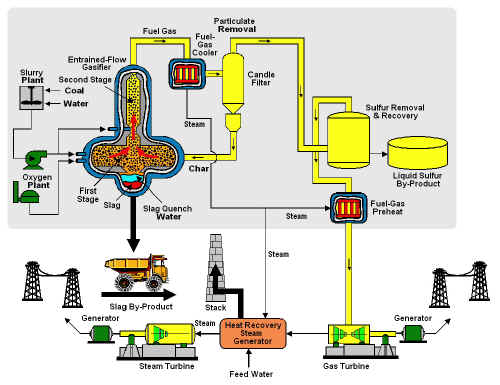
 |
Wabash River Coal Gasification Repowering ProjectAdvanced Electric Power Generation
|
|
| |
|
Participant Location Plant Capacity/Production Technology Coal |
|
Additional Team Members | |||||||
| |||||||||
Project Objective
To demonstrate utility repowering with a two-stage pressurized oxygen-blown entrained-flow IGCC system, including advancements in the technology relevant to the use of high-sulfur bituminous coal and to assess long-term reliability, availability, and maintainability of the system at a fully commercial scale.
Technology/Project Description
Coal is ground in a rod mill slurried with water, and gasified in a pressurized, two-stage (slagging first stage and non-slagging entrained-flow second stage), oxygen-blown, gasifier. The product gas is cooled through heat exchangers and passed through a conventional cold gas cleanup system which removes particulates, ammonia, and sulfur. The clean, medium-Btu gas is then reheated and burned in an advanced 192-MWe (gross) GE 7FA (MS 7001) gas turbine. Hot exhaust from the gas turbine is passed through a heat recovery steam generator to produce high-pressure steam. High-pressure steam is also produced from the gasification plant and superheated in the heat recovery steam generator. The combined high-pressure steam flow is supplied to an existing, refurbished 104-MWe (gross) steam turbine for a total output of 296 MWe (gross).
The process has the following subsystems: a coal-grinding and slurry system, an entrained-flow coal gasifier, a syngas heat recovery system, a cold gas cleanup system that produces a marketable sulfur by-product, a combustion turbine capable of using coal-derived fuel gas, a heat recovery steam generator, and a repowered steam turbine.
One of six units at Wabash River Generating Station was repowered. The demonstration unit generates 262 MWe (net) using 2,544 tons/day of high-sulfur (2.3-5.9% sulfur) Illinois Basin bituminous coal. The anticipated heat rate for the repowered unit is approximately 9,000 Btu/kWh (38% efficiency). Using high-sulfur bituminous coal, SO2 emissions are expected to be less than 0.1 lb/106 Btu (99% reduction). NOx emissions are expected to be less than 0.1 lb/106 Btu (90% reduction). Particulate emissions are expected to be negligible. The project represents the world's largest singletrain IGCC plant currently in operation.
Project Status/Accomplishments
The project began operations in November 1995 and continues in its third year of commercial service. CINergy, PSI's post-merger parent company, preferentially dispatches the unit second behind its hydro facilities on the basis of environmental emissions and efficiency, with a demonstrated heat rate of better than 9,000 Btu/ kWh (HHV). Late 1998 operating statistics showed an annual availability of 77.2%. Since initiating operation in 1995, the unit has achieved monthly production levels of one trillion Btus on four occasions. Refinements to the design are continuing, including replacement of ceramic candle particulate filters with a metallic filter (operating temperature 800 ºF) and installation of a chloride scrubber and new COS hydrolysis catalyst for SO2 control.
Both the gasifier and combined-cycle plants have demonstrated the ability to run at capacity and within environmental compliance while using locally mined, high sulfur coal. Early identification of availability limiting process problems within the gasification plant led to aggressive implementation of improvements which have nearly tripled production since operations began. In October 1998, the project reached milestones of 10,000 hours of coal-fired operation and one million tons of coal processed.
Commercial Applications
Throughout the United States, particularly in the Midwest and East, there are more than 95,000 MWe of existing coal-fired utility boilers over 30 years old. Many of these aging plants are without air pollution controls and are candidates for repowering with IGCC technology. Repowering these plants with IGCC systems will improve plant efficiencies and reduce SO2, NOx, and CO2 emissions. The modularity of the gasifier technology will permit a range of units to be considered for repowering, and the relatively short construction schedule for the technology will allow utilities greater flexibility in designing strategies to meet load requirements. Wabash River was designed, permitted and built in less than four years. Also, the high degree of fuel flexibility inherent in the gasifier design will provide utilities with more choice in selecting fuel supplies to meet increasingly stringent air quality regulations.
Given the advantages of modularity, rapid and staged on-line generation capability, high efficiency, fuel flexibility, environmental controllability, and reduced land and natural resource needs, the IGCC system is also a strong contender for new electric power generating facilities. Commercial offerings of the technology will be based on a 300-MWe train, which is ideally suited to utility-scale power generation applications. The system heat rate for a new power plant based on this technology is expected to realize at least a 20% improvement in efficiency compared to a conventional pulverized-coal-fired plant with flue gas desulfurization. The improved system efficiency also results in a similar decrease in CO2 emissions.
Destec Energy and CINergy Corp./PSI Energy received the 1996 Powerplant Award from Power magazine. Sargent & Lundy, engineer for the combined-cycle facility, won the American Consulting Engineers Council's 1996 Engineering Excellence Award.
Contacts
Phil Amick, Director of Gasification Development
Dynegy Power
Corp.
1000 Louisiana St., Suite 5800
Houston, TX 77002
(713) 767-8667
(713) 767-8515
(fax)
pram@dynegy.com
George Lynch, DOE/HQ, (301) 903-9434 george.lynch@hq.doe.gov
Leo E. Makovsky, NETL, (412) 386-5814 makovsky@netl.doe.gov

